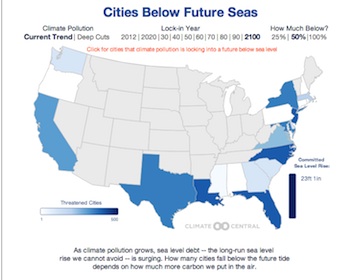Based on past and current emissions, some global warming trends are already too late to stop – the US has "locked in" sea level rise of at least four feet during this century, concludes research by Climate Central.
That’s enough to submerge more than half the population in 316 coastal cities and towns when high tide rolls in – home to about 3.6 million people.
Of course it gets even scarier, if the status quo continues.
"By the end of this century, if global climate emissions continue to increase, that may lock in 23 feet of sea level rise, and threaten 1,429 municipalities that would be mostly submerged at high tide," writes Ben Strauss, vice president for Climate Impacts and Director of the Program on Sea Level Rise at Climate Central. "Those cities have a total population of 18 million. But under a very low emissions scenario, our sea level rise commitment might be limited to about 7.5 feet, which would threaten 555 coastal municipalities: some 900 fewer communities than in the high-emissions scenario."
Right now, the water is encroaching on US coasts by about one inch per decade, but Climate Central anticipates increases of closer to one foot per decade in the near-term future.
Last year, reports warned that sea levels on both the East and West coasts of the US are rising much faster than expected.
In its analysis, Climate Central considers a place to be "threatened" if at least half of the current population lives below the sea levels expected at high tide by 2100.
Florida is particularly vulnerable, but Louisiana, New Jersey and North Carolina also have plenty of threatened communities under that definition. If current carbon pollution trends continue, Climate Central says more than 100 cities and towns will be threatened in each of these states.
Nationally, the biggest threatened cities include Miami, Virginia Beach, VA.; Sacramento, CA.; and Jacksonville, FL.
The graphic below shows areas that would be flooded at high tide in 2100, under the scenario described above. The threatened areas are represented in blue:

If you use a lower threshold for giving communities a threatened stats –- say, if 25% of the current population lives below the projected high-tide sea levels for 2100 — you can add major cities including Boston, Long Beach, CA., and New York City to the list.
The analysis doesn’t account for any solutions that cities may be putting into place for protection, such as the network of levees and flood barriers in New Orleans or a series of measures that proposed for New York City. It does suggest that areas such as South Florida will be especially difficult to protect because of its geological makeup.
The impact would be reduced significantly under a low-emissions scenario that calls for a halt to global emissions growth by 2020, followed by rapid reductions and clean-up actions. But that is extremely unlikely given the current political climate.
The average rate of global sea level rise was about one half-foot per century during the 20th century, just half the current rate. A middle-of-the-road projection for this century is sea level rise of about 5 feet by 2100, notes Climate Central.
"Such rates, if sustained, would realize the highest levels of sea level rise contemplated here in hundreds, not thousands of years — fast enough to apply continual pressure, as well as threaten the heritage, and very existence, of coastal communities everywhere," writes Strauss.
Read the Climate Central analysis, published in the Proceedings of the National Academy of Sciences:
